“Save Our Brothers” Ardennes 1944
Hi, friends, I show you my last humble work, I hope you enjoy it
The Battle of the Bulge, also known as the Ardennes Counteroffensive, took place from 16 December 1944 to 25 January 1945, and was the last major German offensive campaign on the Western Front during World War II. It was launched through the densely forested Ardennes region of Wallonia in eastern Belgium, northeast France, and Luxembourg, towards the end of the war in Europe. The offensive was intended to stop Allied use of the Belgian port of Antwerp and to split the Allied lines, allowing the Germans to encircle and destroy four Allied armies and force the Western Allies to negotiate a peace treaty in the Axis powers' favor.The "Bulge" was the largest and bloodiest single battle fought by the United States in World War II and the second deadliest battle in American history.
Hotton is a Walloon municipality of Belgium located in the province of Luxembourg. The municipality lies 12 kilometers from Marche-en-Famenne in the Ardennes and has more than 5,400 inhabitants. The river Ourthe crosses Hotton.
In the afternoon of 11 May 1940, Hotton was captured and occupied by the 5th Panzer Division during the Battle of Belgium. Allied forces tried in vain to blow up the steel bridge over the Ourthe in an attempt to slow down German forces. Hotton played an important role during the Battle of the Bulge, as German troops (116th Panzer Division Der Windhund and the 560th Volksgrenadier Division) reached here the most western point of their advance here, being stopped by the American 84th Infantry Division Railsplitters
The village of Hotton was once a village under heavy attack during the battle of the bulge. It was the most Western part of the German advance and they needed the Hotton bridge to cross the Ourthe. They never reached that bridge.
The Hotton war cemetery was build and is maintained by the commonweatlh war graves commission. The architect of the cemetery is Philip Hepworth.
Most of the soldiers buried there, died in the operations to hold and drive back the Germans.
Of the 667 war burials, 340 are soldiers, 325 airmen and 1 war correspondent.
527 are British, 88 Canadian, 41 Australian, 10 New Zealand and 1 Polish.
There is also one Belgian soldier who fought with the 53rd Welsh Division.
On the plaque, outside of the cemetery you will find this information:
ìOn 16th December the Germans launched their last counter-offensive of the war against the lightly held Ardennes sector. Its object was to recapture Brussles and Antwerp and cut the Alliesísupply lines. The advance, 50 miles at tis maximum, was halted on Christmas eve. On 3rd January the Americans, with some British reinforcement, struck back and within 4 days the Germans were withdrawing. Meanwhile British Second Army eliminated the bridgehead west of the Roer and the Americans and French dealt similarly with the salient south of Strasbourg.
"Save our brothers"- Roberto Scibilia 2019 1/35 diorama
1/35 Miniart 35515 Ardennes Building, 1/35 Miniart 35084 Battle of the bulge - figures, 1/35 Miniart 38011 Villagers - figures, 1/35 Miniart 35548 Furniture set
everything else not mentioned above has been completely self-built

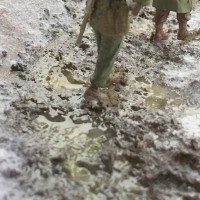







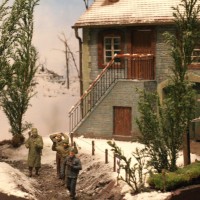

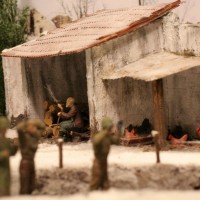










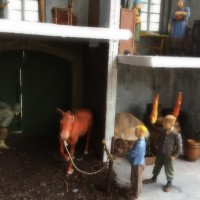
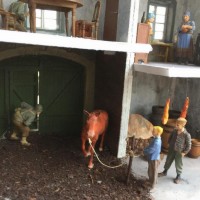
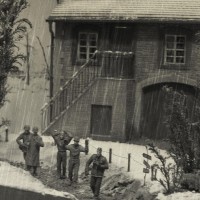




Great work roberto! How do you make the snow?
Hi Patrick, thank you... The snow was made in three step:
I sifted the snow powder of Woodlands scenics over a very diluted vinyl glue. I let it dry well, then I sprayed hairspray and sieved sodium bicarbonate in small layers. for thicker parts I used the tamiya snow paste "tamiya snow effect"
Thank you 🙂
if you need anyt informations do not hesitate to ask, hello !
Sublime; storytelling in miniature.
‘Liked’
Thank you David, very much 🙂
Beautifully done, Roberto! Outstanding details. It tells quite a few stories, depending on where you look.
Hi Jeff, that's exactly what I meant to accomplish. If you look at the diorama from the front, you see some poor prisoners escorted by German soldiers who are probably going to make a bad end. If you see the diorama on the opposite side, the hope of a liberation becomes light. thank you very much for the comment, a hug from Italy
Very nice - many "layers" to the work!
thank you Greg, there are many stories in the same diorama..
Nicely done Roberto, and a well written narrative as well. I have a connection to the Ardennes Offensive as my father fought with the 101st Airborne surrounded in Bastogne. After being relieved he was evacuated to a field hospital in England with what was termed trench foot . Tough weather and bitter cold and no cold weather gear as well, make for difficult fighting conditions. You captured the winter scene really well.
Thank you Tom for sharing with me your beautiful family story, thanks for the friendship and for your appreciated comment.